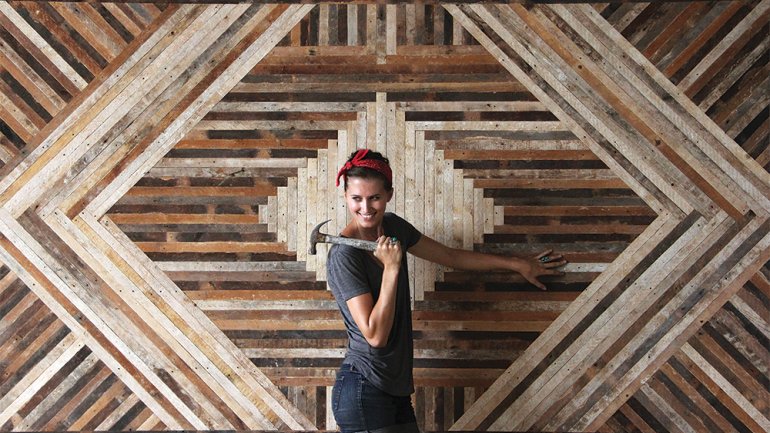Past Perfect
Past Perfect
A hundred years ago, Brooklyn homebuilders erected walls by hanging lath – three-quarter-inch strips of unfinished wood set parallel to the ground – and covering it in plaster. A century later, contractors are refurbishing buildings in New York City’s largest borough to ease the progress of gentrification. The old walls come down, drywall goes up; rents rise, and new people move in. The lath winds up in the Dumpster. Unless Ariele Alasko spots it first.
For the past year and a half, the industrious Brooklynite has made a practice of collecting lath from New York’s work sites and turning it into headboards, wall panels, and tabletops decorated with handsome geometric designs.
It all started by chance. After graduating in 2009 from Pratt Institute’s School of Art and Design, where she studied sculpture, Alasko worked as an artist’s assistant. She quit (“because I love quitting things”) and was in the process of refiguring her life when she got a call from her dad. He wanted to open a restaurant near Alasko’s hometown of Monterey, California. His daughter always had been a natural maker, intuitive and gifted with tools and materials. Would she come out west and build it?
So in March 2011, Alasko loaded a 16-foot U-Haul with every piece of wood she could find and made her way across the country. Over the next six months, she labored 12 hours a day, seven days a week, to build out most every detail in the 2,500-square-foot restaurant – called Il Vecchio (“the Old One”) – constructing everything from tables and chairs to paneled walls and the bar. Meanwhile, she started a blog, Brooklyn to West, to document the process, and the name stuck to her furniture-making business.
Her task finished, Alasko returned to Brooklyn, determined to stick with woodworking, and discovered that lath has several advantages. It’s free, when she can find it, and years under plaster work on wood in mysterious ways, coloring it all shades from oxblood to ash. Lath is also relatively easy to work with. Alasko planes pieces to consistent widths, cuts them to the desired angles, and uses a nail gun to affix them to sheets of plywood, the only material she uses that isn’t reclaimed.
Best of all, perhaps, is that her work can serve as a Trojan horse to return pieces of the city’s past to its newly modernized homes. “Brooklyn’s being gutted left and right,” she says. “A lot of time, the people who buy from me are the same ones moving into the gutted houses.”
Surrounded by neat piles of lath and works in progress – there’s a tabletop that’s been hanging on a wall for months as Alasko searches for the right material from which to construct a base – Alasko reflects on change, which in her part of the world is ever-present.
She keeps her studio in a large industrial building across the street from the housing projects in which the rapper Jay-Z was raised. One floor below her, there’s a factory that makes coats for the Hasidic Jews who live in the neighborhood – for now. Since Alasko (and studiomate Amelie Mancini of Left Field Cards) moved in and remodeled the space last summer, the landlord has begun giving old tenants the boot and creating more space for artists, who will pay higher rents.
“People tear out everything that has any character to make things easier and cheaper,” Alasko says. “I want to take something that doesn’t look great when it’s sitting in the pile, and turn it into something beautiful.”
Patrick Clark is a writer and lifelong New Yorker who has forgiven the real estate developers for gutting Brooklyn.

